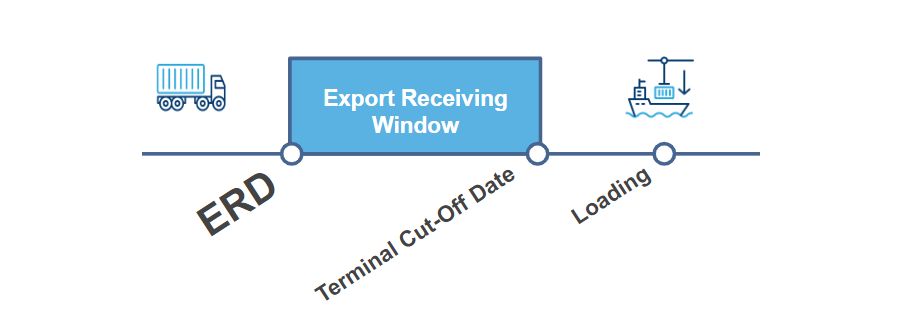Earliest Return Dates / ERDs: How to manage them and avoid extra costs
Container shipping operations
Shippers know the struggle of managing Earliest Return Dates (ERDs). These crucial dates play a vital role in the smooth flow of container shipments, dictating when containers can be delivered to their designated terminals. However, the constant fluctuations and revisions in ERDs can create challenges for shippers, impacting delivery schedules, operational efficiency, and overall costs.
What is the Earliest Return Date and why is it important for shippers?
The concept of the earliest return date (ERD) was developed as a solution to alleviate issues with terminal congestion and storage capacity constraints. The earliest return date, also known as the earliest receiving date, earliest receipt date, or early return date, is crucial information for shippers handling containers. This date signifies the first allowable time for an export container to be delivered to its designated terminal.
Working in conjunction with the terminal cut-off date, also referred to as the last return date, the ERD establishes a designated timeframe known as the export-receiving window.

Missing the ERD can have costly consequences, e.g. impacting delivery schedules, operational efficiency, and extra costs. Shippers need to adhere to these dates to ensure a smooth and efficient container transport process.
Who is responsible for publishing the ERD and how do shippers utilize this information?
The earliest receive dates are typically released by terminals and shipping companies. ERD data is not always consistent between carriers and terminal. In theory ERD most accurate data provider should be the terminal operator (to manage the maximum number of container manageable on site), but inconsistent data between carriers and terminal are posing a challenge for shippers in their drayage planning.
Example of message from Georgia Ports (https://gaports.com/vessel-schedule/)

Each shipping company operates its own system or platform for disseminating ERD details to customers, usually accessible through their website or customer support channels.
These ERDs are presented in various formats such as HTML, Excel or PDF. Shippers must gather and consolidate ERDs from multiple transport providers, then distribute them to their drivers to enhance drayage operations. It's crucial to constantly update this data as ERDs can change frequently, leading to significant repercussions. Inaccurate ERDs could result in costs of up to $1000 per shipment. According to a survey by the US Agriculture Transport Coalition (AgTC), at least 5% of shipments face additional expenses due to ERD alterations.
What kind of costs are incurred when missing the ERD?
If a container arrives prior to the ERD, there may not be sufficient storage space, leading to a potential return to its origin, or there will be demurrage charges incurred if the container is accepted.
a) Drayage expenses
Missing the ERD can result in increased drayage expenses. If the container arrives too early at the terminal, it will be rejected and need to be transported back to the loading location (stuffing site or haulier depots), leading to additional handling and storage charges.
It is not uncommon for transportation managers to discover just a day before loading that the ERD has been postponed by 2 days, and the window for exporting goods has decreased from 4 days to 2 days.
If the transportation manager is unable to adjust the loading schedule, it can result in extra storage costs at the yard and added drayage expenses.
It is crucial for shippers to be informed of ERDs and any changes promptly in order to adjust loading schedules and minimize drayage costs.
b) Demurrage charges
If the container arrives before ERD but the vessel is open to receiving, the container will be received and demurrage charges will incur.
Charges are determined by the shipping line, which will vary based on the carrier, terminal, container type & size, destination, number of days, etc. For example the tariff from ONE varies from $160 to $220 per container per day (source: https://ecomm.one-line.com/one-ecom/prices/basic-tariff).
Business Problem Caused
The frequent and sudden changes to ERDs cause a ripple effect, resulting in unexpected additional charges for shippers and ultimately impacting their costs of goods sold and margins. Shippers are investing significant time and effort in constantly updating and sharing ERD data to mitigate these cost impacts and to provide explanations to senior management when necessary.
Accurate ERD data is crucial for evaluating the level of service provided by shipping lines. The increased frequency and shorter notice of ERD changes significantly disrupt the container shipping process, a key factor shippers consider when negotiating tenders with shipping lines.
How BuyCo enables shippers to be on top of their ERDs and terminal cut-off dates?
BuyCo provides shippers with a centralized hub for all their ERDs and terminal cut-off dates, eliminating the need to navigate multiple terminal websites. This streamlined approach allows shippers to easily share ERD data with all involved parties, from their transport teams to trucking partners. With BuyCo's real-time verification of ERDs every hour, shippers are promptly informed of any changes.
By automating the collection of ERD and cut-off data, BuyCo simplifies the process of export-receiving windows, ensuring that shippers' information remains accurate and synchronized.
A BuyCo shipment card including ERD, terminal cut-off, and ETD
Leveraging BuyCo's advanced data connectivity, translation, and automation capabilities, container scheduling becomes seamless, efficient, and automated. BuyCo empowers shippers to:
- Stay on top of schedule changes with enhanced visibility into ERD and terminal cut-off data.
- Streamline operations by eliminating the need for manual data validation, as BuyCo handles the collection and reconciliation of logistics data.
- Effectively manage costs by providing clear and comprehensive information on container scheduling.
- Quickly kickstart operations with seamless multi-source data integration behind the scenes.
BuyCo: Shifting from ERD visibility to taking concrete steps in drayage operations
BuyCo doesn't stop at collecting ERD and cut-off dates. It takes it a step further by empowering shippers to act swiftly on ERD changes, streamlining the entire container shipment process for exports. Once alerted to an ERD change, BuyCo automatically notifies the truckers, allowing them to adjust their drayage plans accordingly.
BuyCo consolidates all necessary data for overseeing your exports in a centralized location. Additionally, it offers a comprehensive platform to efficiently manage all shipping operations for exports:
- Shipment planning with access to sailing schedules, ERDs and cut-off dates
- Shipment booking, connecting to all shipping lines
- Shipping instructions and VGM declaration management, with control over document and VGM cut-off dates
- Automatic AES US Export filling connected directly to CBP.
- Collaborative document management at shipment level
- Tracking containers at every milestone, including actual dates, estimated and predicted dates.





